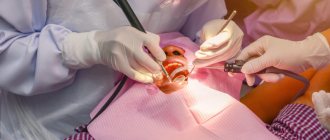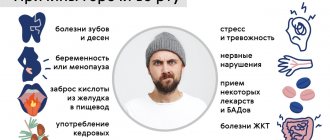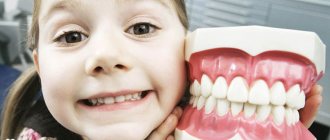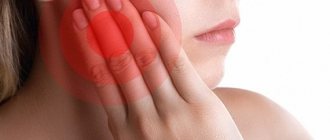Why do you need to brush your teeth?
Oral hygiene is not only a matter of aesthetics. It is due to medical reasons. A plaque constantly forms on the enamel, consisting of: • food particles; • saliva; • waste products of microorganisms inhabiting the oral cavity.
The process of plaque deposition does not depend on whether a person ate in the interval between brushings. If it is not removed, over time it turns to stone. Contamination not only creates a cosmetic defect. Deposits contribute to the violation of the integrity of the enamel. Pathogenic bacteria penetrate into the resulting cracks and actively multiply under conditions of poor hygiene. This is how caries begins with all the known consequences. These microorganisms also attack the gums. In people who neglect to brush their teeth, gingivitis becomes chronic. If the inflammation is not treated, complications in the form of periodontitis and periodontal disease are possible. As a result, the root no longer holds in the socket and the tooth falls out.
How to replace toothpaste at home
Traditional (homemade) toothpaste substitutes include many substances and compositions. It is worth considering that it is not advisable to consider them as a long-term alternative, since their action is rather narrowly focused and in some cases their effectiveness does not have high indicators.
Activated carbon
Can be used both in pure form and with the addition of hydrogen peroxide. The latter has an antimicrobial effect, while the charcoal itself cleans and whitens tooth enamel. For one use, 1 tablet and 1-2 drops of peroxide are enough. Activated carbon does not require grinding, because upon contact with liquid it takes on a mushy state.
Charcoal has a good whitening effect. It should be noted that charcoal is a fairly active abrasive and, with prolonged use, can have a traumatic effect on tooth enamel.
Powder for teeth
You can prepare tooth powder at home by mixing: bentonite clay (30g), soda (30g), xylitol (15g), sea salt (7.5g), mint oil (5 drops), dried sage leaves (15g). The mixture is mixed with a wooden spatula and stored in a tightly closed container. This powder is a good replacement for toothpaste at home and in other conditions and is an almost exact analogue of the powder produced under industrial conditions. However, it is worth considering that any powder is an abrasive agent and requires short-term use to avoid damage to the enamel.
Salt
You can use either regular table salt or sea salt. Salt has a good anti-inflammatory effect, but it must be used carefully, mixed with water until it becomes pasty. Otherwise, hard particles with sharp edges can lead to microdamage to the enamel and cause increased tooth sensitivity.
Soda
It is another abrasive agent in the question of “ what to replace toothpaste with .” To create a cleaning mass, 1/2 teaspoon of baking soda must be mixed with 1/4 part of water. This mixture freshens breath and fights well against plaque on teeth, preventing the formation of tartar. To achieve a whitening effect, you can add 1-2 drops of lemon juice to the soda. Please note that after cleaning with soda, it is advisable to avoid drinking hot and cold drinks and food for 1-2 hours to prevent cracking of the enamel.
Herbal preparations
Mint, cloves, sage, thyme, anise and calamus root can be used as constituent units. Crushed roots of calamus can be mixed with an aqueous solution of propolis in almost arbitrary proportions.
The use of such mixtures has a beneficial effect on the gums and mucous membranes of the oral cavity. This type of hygiene products should be used with caution, taking into account the possibility of individual intolerance and the risk of developing allergic reactions.
Tea tree oil
Tea tree-based compositions have a good antibacterial and aromatizing effect. The composition is prepared by adding tea tree oil to warm water at the rate of 3-4 drops per glass of water. Such treatment has a particularly beneficial effect on the gums of people prone to developing periodontal disease and caries.
Banana peel
Few people know that banana peel has a good cleansing agent and whitening effect.
Powdered milk
Has a beneficial effect on the gums of people prone to bleeding. Produces gentle cleaning while neutralizing unpleasant odors.
Ash
You cannot use ash from resinous wood or recycled plywood. As a replacement for toothpaste, willow, birch, linden and oak are best suited for these purposes. Ash has a good bleaching effect and can serve as a good alternative to activated carbon due to its fineness, which allows for gentle cleaning.
White clay
It can be used both as an independent product and as part of a homemade combined tooth powder.
Laundry soap
Soap is a good antibacterial and antimicrobial agent. The main disadvantage of this method of cleaning teeth is the unpleasant taste in the mouth.
Lagerstroemia (Indian lilac)
A plant component with powerful antibacterial and anti-inflammatory effects. Provides a good therapeutic effect in the treatment and prevention of gingivitis, caries and some other diseases of the oral cavity.
Oils
Coconut oil and tea tree oil are popular alternatives to toothpaste. Most are used as rinsing solutions and as a component of herbal mixtures.
How to brush your teeth correctly?
It is a mistaken idea that everyone can do this. There are a number of rules, many of which are either unknown or ignored. However, only compliance with them guarantees effective cleaning of the enamel: • Carrying out hygiene procedures not only at home, but also at the dentist. • Rational selection of brushes and paste. • Using the optimal teeth brushing method. • Using dental floss, brushes and mouthwash. • Taking into account the condition of the gums, the presence of braces and dentures. • Compliance with the rules for storing, cleaning and replacing brushes.
Tablets for determining plaque will help you understand whether you have achieved your goal. They demonstrate whether unwanted deposits are present on the enamel. They also suggest which areas are not being worked through carefully enough.
Choosing a toothbrush
To completely clean the enamel from plaque, you need to choose a suitable brush. The easiest way to do this is by material. There are two options here - natural and synthetic. It is better to give preference to the latter, since they are quite elastic, and the tips of the hairs are usually rounded, which is safer for the gums. Bacteria multiply faster on natural materials.
In terms of the stiffness of the bristles, toothbrushes are: • Soft. They are best taken for children, adolescents and people suffering from gingivitis. • Average. A universal option for people without dental problems. • Tough. They help fight hard plaque and can be used only when indicated.
The configuration of the bristles should be discussed with your dentist. It will tell you where more sediment collects. For example, if you need to better work on the necks of teeth, bristles collected in bunches can handle this.
Diet for lactase deficiency
What rules should you follow to prevent diarrhea after milk?
You should limit your consumption of dairy products. In addition, you need to remember that lactose is also contained in other products. It is present in baked goods, omelettes, semi-finished products, and confectionery products.
Nutrition rules:
- combine milk with cereal products;
- consume dairy products in small quantities;
- replace with lactose-free analogues.
The fat content of milk does not affect the amount of lactose. Therefore, if you reduce fat content, it will not save you from diarrhea.
Lactose content in products, per 100 g:
| product | quantity |
| powdered milk | 51.5 g |
| condensed milk 10% | 12.5 g |
| condensed milk with sugar | 10.2 g |
| milk 3.5% | 4.8 g |
| ice cream | 1.9-7.0 g |
| milk yogurt | 4 g |
| creamy yogurt | 3.7 g |
| kefir | 6.0 g |
| cottage cheese | 2.6 g |
| sour cream 10% | 2.5 g |
| milk chocolate | 9.5 g |
| curdled milk | 4.1 g |
| nougat | 25 g |
| milkshake | 5.4 g |
If you have problems with lactase deficiency, you should pay attention to the composition of the products and the lactose content in them.
Pasta selection
Pastes are hygienic, preventive and therapeutic. The first ones solve the only problem - clean the enamel. The latter, due to the antiseptic component, help prevent the development of gingivitis and caries. Still others are prescribed by dentists for therapeutic purposes; it is better not to use them on your own.
Toothpastes are also distinguished according to the results of use: • whitening - slightly lighten the enamel, but you should not expect drastic changes from them; • strengthening – contain fluoride, good for enamel health; • desensitizing - reduce sensitivity; • anti-inflammatory - help with gingivitis.
Abrasiveness characterizes the degree of impact on plaque. The average value of this indicator is from 50 to 80. Higher values can be taken occasionally to lighten teeth. Lower abrasiveness is indicated for sensitive enamel and gums.
Proper brushing of teeth: sequence of movements
For hygiene purposes, you need to accustom yourself to a certain sequence of movements.
After squeezing the paste onto the brush, you must: • apply it to the teeth at an angle of 45 or 90 degrees; • pass each one 3-4 times in the direction from the gums to the cutting edge; • treat chewing surfaces with circular movements; • Allow at least 30 seconds of brushing for each half of the jaw. Depending on the location of the brush and the direction of movement, there are three methods of brushing teeth. The most famous (90 degree brush, top to bottom movements) is the Leonard method.
The Bass method involves choosing an angle of 45 degrees and making vibrating movements. It is good because the bristles penetrate into the interdental spaces and partially work out the contact surfaces. With the Fones method, an angle of 90 degrees is taken and the brush moves in a circle. This further massages the gums, which improves blood circulation and protects against inflammatory processes.
Additional oral cleansing
Oral hygiene is not limited to two rows of teeth. For complete cleansing it is necessary to treat: • Interdental spaces. Dental floss or a brush will help remove plaque. • Language. To do this, use the relief surface of the back of the toothbrush or a special scraper. • Gums. They are partly cleaned with a brush: at an angle of 45 degrees, the bristles approach the edge and capture deposits. Rinse aid also helps. • Cheeks. You can go over them with the back of the brush, but they require more rinsing.
You need to start by removing the largest food debris. To do this, just rinse your mouth with water. Then comes the turn of fragments stuck in the interdental spaces - this is where floss comes to the rescue. Now you can take up the brush with the paste. Rinse aid is used last - to create a protective layer.
How to brush your teeth with gingivitis?
Inflammation of soft tissues is not a reason to neglect hygiene. On the contrary, the more often cleansing is done, the less chance bacteria have to support the inflammatory process.
However, you need to take precautions: • choose brushes with soft bristles (preferably rounded); • choose a paste with low abrasiveness and containing medicinal herbs; • give preference to the Bass method, and abstain from the Fones method until remission; • move your hand more carefully to avoid painful sensations.
Cleaning time should not be shortened, even if the procedure causes discomfort. Sometimes dentists even recommend increasing it. Inflammation of the gums is accompanied by the formation of pockets. Where their edges lag behind, stone grows with particular intensity. This place deserves more careful study.
Is it possible to cure pathology?
What to do if the diagnosis of lactase deficiency is confirmed by a doctor? How to treat, what to do so that the unpleasant sensations do not recur?
For lactase deficiency, elimination diet therapy is prescribed. In other words, it is necessary to limit the consumption of products containing lactose.
With alactasia, when the body is unable to process foods containing lactose, a special diet is prescribed for life. It is necessary to exclude products with lactose.
Preparations are produced that supply the necessary enzymes.
The pharmaceutical industry produces the following drugs:
- medicines with the necessary enzyme, for example, Laktrazar, they are taken simultaneously with products containing lactose;
- preparations with lactose, for example, Lactaid, they are added to milk.
Using these drugs, you can consume foods containing lactose without unpleasant consequences.
How to clean dental structures?
Dental structures in the mouth make adjustments to the cleaning process: • Crowns. More attention should be paid to the area where the gums come into contact with the prosthesis. • Bridges. A round mono-tuft brush is more suitable for them. • Veneers. The teeth where they are installed cannot be treated with floss. The ban does not apply to other methods. • Braces. The space under the arch and the area adjacent to the enamel is cleaned with brushes.
In all of the above cases, it is necessary to use an irrigator. Conventional cleaning devices are not able to penetrate all the places where plaque accumulates. There are no barriers for water. Under the pressure set by the device, it knocks out stuck food fragments, preventing them from decomposing or turning into stone.
Composition of toothpaste
- The basis. Almost any toothpaste is based on water and a mixture of glycerin and sorbitol, which acts as a binding component;
- Abrasives. Any paste contains abrasive particles in one quantity or another. In ordinary pastes there is a minimal amount of them, in pastes with a whitening effect they make up the largest part of the composition. Most often, silicon oxide derivatives are used as such abrasive particles;
- Foaming agents. The foam formed during the process of brushing teeth allows you to most effectively remove even microscopic particles removed from the surface, acting as a kind of dirt trap;
- Thickeners. These components are necessary to impart uniformity to the composition, making the paste convenient to apply to a toothbrush and distribute over the surface of the teeth;
- Excipients. Such substances include dyes, flavors, sweeteners and therapeutic and preventive additives that give an attractive color, in cases where we are talking about pastes with a targeted effect.
Having considered the composition and principle of action of toothpaste, you can reasonably select product options and make a decision: what can replace toothpaste with .
How do plaque tablets work?
We usually contact a dentist to assess the quality of oral hygiene. It identifies areas that are not cleaned effectively and makes recommendations for replacing the paste or brush. But in between visits to the clinic, you can cope without the help of a doctor.
Special tablets, developed by the Swiss company CURADEN, will help with this. They are part of the CURAPROX range of dental care products. Determination of plaque occurs as follows: • the tablet is diluted in water; • after brushing, a person rinses his mouth with this solution, distributing it over his teeth; • deposits are stained, clean enamel remains intact.
The tablets also help distinguish soft plaque from tartar. The first one becomes pink, the second one becomes dark blue. This way you can understand whether it’s time to go for ultrasonic cleaning.
Consequences of not brushing your teeth properly
Proper and timely cleaning of dental plaque is protection against oral diseases.
If you neglect it, the consequences will only increase: • Tartar forms. It gives off an unpleasant odor. If you do not carry out ultrasonic cleaning, it will become a favorite place for bacteria. • Bacteria will destroy the enamel. The abundance of pathogenic microorganisms quickly leads to caries. • Bacteria will cause your gums to become inflamed. Soft tissues are no less sensitive to them than hard ones. And this means bleeding, swelling and an unpleasant odor.
Possible complications are also worth mentioning. Caries develops into pulpitis, which requires removal of the nerve. This deprives the tooth of nutrition, as a result of which it sooner or later collapses. Progressive gingivitis is fraught with periodontitis and periodontal disease. Lack of oral hygiene leads to tooth loss. Restoring them is more expensive than the cost of a brush, paste and professional cleaning. Therefore, it is better to remember these simple rules and follow them.
What you don't know about toothpastes
Regardless of the price and manufacturer, any toothpaste contains aggressive chemical compounds, metal salts, and antibiotics. Over the years, harmful substances slowly but steadily accumulate in the body, causing a number of problems:
- disrupt the functioning of the digestive system;
- provoke allergies;
- thinning tooth enamel;
- irritate the gums, dry out the oral mucosa;
- load the kidneys and liver;
- destroy bone tissue;
- impair memory;
- lead to dysbacteriosis;
- slow down metabolism;
- suppress the immune system;
- reduce vision.
In 30-40 seconds, part of the composition is absorbed through the mucous membrane. Toxic components enter the blood and spread throughout the body. It turns out that every day, morning and evening, we slowly poison ourselves.
Toothpaste can cause significant harm to a pregnant woman: lead to changes in hormonal levels, affect the formation of the fetus.
Children are at risk - the effects of some pastes can affect growth and development.











